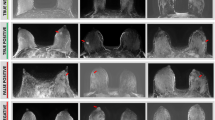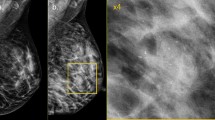Abstract
Purpose
The purpose of this study is to investigate the detectability of pregnancy-associated breast cancer (PABC) in lactating glandular tissue on magnetic resonance imaging (MRI) by using pre- and post-contrast acquisitions and their derived postprocessed images and compare these results to ultrasound (US) and mammography (MG).
Materials and methods
We reviewed the electronic database for women with PABC and existing breast MRI. MR images (T2-weighted short inversion-recovery sequence [STIR], dynamic contrast-enhanced T1-weighted gradient echo sequence and postprocessed subtraction images [early post-contrast minus pre-contrast]) were retrospectively evaluated (image quality, parenchymal/tumour enhancement kintetics, tumour size and additional lesions). Supplemental subtraction images (latest post-contrast minus early post-contrast) to reduce plateau enhancement were additionally calculated and tumour conspicuity and size were measured. Findings were compared to US and MG reports.
Results
Nineteen patients (range 27–42 years) were included. Background parenchymal enhancement (BPE) was minimal (n=1), mild (n=3), moderate (n=7) and marked (n=8) with kinetics measured plateau (n=8), continuous (n=10) and not quantifiable (n=1). Tumour kinetics presented wash-out (n=17) and plateau (n=2). Eighteen of nineteen tumours were identified on the supplemental subtraction images. All tumours were visible on US; 12/19 were visible on MG (63.2%). MRI detected additional malignant lesions in two patients.
Conclusion
Despite high BPE of the lactating breast, MRI securely detects carcinomas and identifies satellite lesions. By using supplemental subtraction images, background enhancement can be eliminated to facilitate diagnosis. US remains a reliable diagnostic tool, but additional MRI is recommended to rule out satellite/contralateral lesions. MG interpretations can be difficult due to high parenchymal density.
Key Points
• Despite high background enhancement, MRI of the breast confidently detects carcinomas and identifies further lesions in the lactating breast.
• By using supplemental subtraction images, background enhancement in the lactating breast can be eliminated to facilitate diagnosis.
• US remains a reliable diagnostic tool. Mammography can be limited due to extremely dense breast tissue related to lactation.



Similar content being viewed by others
Abbreviations
- ACR:
-
American College of Radiology
- BCT:
-
Breast conserving therapy
- BI-RADS®:
-
Breast Imaging Reporting and Data System
- ER:
-
Estrogen receptor
- FOV:
-
Field-of-View
- HER2:
-
Human epidermal growth factor receptor 2
- MG:
-
Mammography
- MIP:
-
Maximum intensity projection
- MRI:
-
Magnetic resonance imaging
- NST:
-
Invasive ductal carcinoma of no special type
- PBAC:
-
Pregnancy-associated breast cancer
- PR:
-
Progesterone receptor
- T:
-
Tesla
- TE:
-
Echo time
- TI:
-
Inversion time
- TR:
-
Repetition time
- US:
-
Ultrasound
References
Oh SW, Lim HS, Moon SM et al (2017) MR imaging characteristics of breast cancer diagnosed during lactation. Br J Radiol 90:20170203
Vashi R, Hooley R, Butler R, Geisel J, Philpotts L (2013) Breast imaging of the pregnant and lactating patient: imaging modalities and pregnancy-associated breast cancer. AJR Am J Roentgenol 200:321–328
Keleher AJ, Theriault RL, Gwyn KM et al (2002) Multidisciplinary management of breast cancer concurrent with pregnancy. J Am Coll Surg 194:54–64
Petrek JA, Dukoff R, Rogatko A (1991) Prognosis of pregnancy-associated breast cancer. Cancer 67:869–872
Sabate JM, Clotet M, Torrubia S et al (2007) Radiologic evaluation of breast disorders related to pregnancy and lactation. Radiographics 27(Suppl 1):S101–S124
Committee on Obstetric Practice (2017) Committee Opinion No. 723: Guidelines for Diagnostic Imaging During Pregnancy and Lactation. Obstet Gynecol 130:e210–e216
American College of Radiology (2017) ACR Committee on Drugs and Contrast Media. https://www.acr.org/-/media/ACR/Files/Clinical-Resources/Contrast_Media.pdf
Giess CS, Yeh ED, Raza S, Birdwell RL (2014) Background parenchymal enhancement at breast MR imaging: normal patterns, diagnostic challenges, and potential for false-positive and false-negative interpretation. Radiographics 34:234–247
Talele AC, Slanetz PJ, Edmister WB, Yeh ED, Kopans DB (2003) The lactating breast: MRI findings and literature review. Breast J 9:237–240
Espinosa LA, Daniel BL, Vidarsson L, Zakhour M, Ikeda DM, Herfkens RJ (2005) The lactating breast: contrast-enhanced MR imaging of normal tissue and cancer. Radiology 237:429–436
Taylor D, Lazberger J, Ives A, Wylie E, Saunders C (2011) Reducing delay in the diagnosis of pregnancy-associated breast cancer: how imaging can help us. J Med Imaging Radiat Oncol 55:33–42
Myers KS, Green LA, Lebron L, Morris EA (2017) Imaging Appearance and Clinical Impact of Preoperative Breast MRI in Pregnancy-Associated Breast Cancer. AJR Am J Roentgenol 209:W177–w183
Ellis RL (2009) Optimal Timing of Breast MRI Examinations for Premenopausal Women Who Do Not Have a Normal Menstrual Cycle. AJR Am J Roentgenol 193:1738–1740
Joshi S, Dialani V, Marotti J, Mehta TS, Slanetz PJ (2013) Breast disease in the pregnant and lactating patient: radiological-pathological correlation. Insights Imaging 4:527–538
Derakhshan JJ, McDonald ES, Siegelman ES, Schnall MD, Wehrli FW (2018) Characterizing and eliminating errors in enhancement and subtraction artifacts in dynamic contrast-enhanced breast MRI: Chemical shift artifact of the third kind. Magn Reson Med 79:2277–2289
Choi BG, Kim HH, Kim EN et al (2002) New subtraction algorithms for evaluation of lesions on dynamic contrast-enhanced MR mammography. Eur Radiol 12:3018–3022
Choi N, Han BK, Choe YH, Kim HS (2005) Three-phase dynamic breast magnetic resonance imaging with two-way subtraction. J Comput Assist Tomogr 29:834–841
Schanler RJ, Potak DC (2018) Physiology of lactation. https://www.uptodate.com/contents/physiology-of-lactation
D’Orsi CJSE, Mendelson EB, Morris EA et al (2013) ACR BI-RADS® Atlas, Breast Imaging Reporting and Data System. American College of Radiology, Reston
Breast Imaging Working Group of the German Radiological S (2014) Updated Recommendations for MRI of the Breast. Rofo 186:482–483
Hogge JP, De Paredes ES, Magnant CM, Lage J (1999) Imaging and Management of Breast Masses During Pregnancy and Lactation. Breast J 5:272–283
Liberman L, Giess CS, Dershaw DD, Deutch BM, Petrek JA (1994) Imaging of pregnancy-associated breast cancer. Radiology 191:245–248
Ayyappan AP, Kulkarni S, Crystal P (2010) Pregnancy-associated breast cancer: spectrum of imaging appearances. Br J Radiol 83:529–534
Gao B, Zhang H, Zhang SD et al (2014) Mammographic and clinicopathological features of triple-negative breast cancer. Br J Radiol 87:20130496
Gruber IV, Rueckert M, Kagan KO et al (2013) Measurement of tumour size with mammography, sonography and magnetic resonance imaging as compared to histological tumour size in primary breast cancer. BMC Cancer 13:328
Funding
The authors state that this work has not received any funding.
Author information
Authors and Affiliations
Corresponding author
Ethics declarations
Guarantor
The scientific guarantor of this publication is Dr. med. Sonja Bahrs.
Conflict of interest
The authors of this manuscript declare no relationships with any companies, whose products or services may be related to the subject matter of the article.
Statistics and biometry
No complex statistical methods were necessary for this paper.
Informed consent
Written informed consent was waived by the Institutional Review Board.
Ethical approval
Institutional Review Board approval was obtained.
Methodology
• retrospective
• observational
• performed at one institution
Rights and permissions
About this article
Cite this article
Taron, J., Fleischer, S., Preibsch, H. et al. Background parenchymal enhancement in pregnancy-associated breast cancer: a hindrance to diagnosis?. Eur Radiol 29, 1187–1193 (2019). https://doi.org/10.1007/s00330-018-5721-7
Received:
Revised:
Accepted:
Published:
Issue Date:
DOI: https://doi.org/10.1007/s00330-018-5721-7




